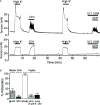Bis-Quinolinium Cyclophane Blockers of SK Potassium Channels Are Antagonists of M3 Muscarinic Acetylcholine Receptors
- PMID: 33041794
- PMCID: PMC7525093
- DOI: 10.3389/fphar.2020.552211
Bis-Quinolinium Cyclophane Blockers of SK Potassium Channels Are Antagonists of M3 Muscarinic Acetylcholine Receptors
Abstract
Dequalinium is used as an antimicrobial compound for oral health and other microbial infections. Derivatives of dequalinium, the bis-quinolinium cyclophanes UCL 1684 and UCL 1848, are high affinity SK potassium channel antagonists. Here we investigated these compounds as M3 muscarinic receptor (mACHR) antagonists. We used the R-CEPIAer endoplasmic reticulum calcium reporter to functionally assay for Gq-coupled receptor signaling, and investigated the bis-quinolinium cyclophanes as antagonists of M3 mACHR activation in transfected CHO cells. Given mACHR roles in airway smooth muscle (ASM) contractility, we also tested the ability of UCL 1684 to relax ASM. We find that these compounds antagonized M3 mACHRs with an IC50 of 0.27 μM for dequalinium chloride, 1.5 μM for UCL 1684 and 1.0 μM for UCL 1848. UCL 1684 also antagonized M1 (IC50 0.12 μM) and M5 (IC50 0.52 μM) mACHR responses. UCL 1684 was determined to be a competitive antagonist at M3 receptors as it increased the EC50 for carbachol without a reduction in the maximum response. The Ki for UCL1684 determined from competition binding experiments was 909 nM. UCL 1684 reduced carbachol-evoked ASM contractions (>90%, IC50 0.43 μM), and calcium mobilization in rodent and human lung ASM cells. We conclude that dequalinium and bis-quinolinium cyclophanes antagonized M3 mACHR activation at sub- to low micromolar concentrations, with UCL 1684 acting as an ASM relaxant. Caution should be taken when using these compounds to block SK potassium channels, as inhibition of mACHRs may be a side-effect if excessive concentrations are used.
Keywords: SK channel; UCL 1684; airway smooth muscle; contraction; dequalinium; muscarinic receptor.
Copyright © 2020 Bugay, Wallace, Wang, Salinas, Chapparo, Smith, Dube, Brooks, Berg and Brenner.
Figures






Similar articles
-
Dequalinium chloride is an antagonists of α7 nicotinic acetylcholine receptors.Eur J Pharmacol. 2022 Jun 15;925:175000. doi: 10.1016/j.ejphar.2022.175000. Epub 2022 May 4. Eur J Pharmacol. 2022. PMID: 35525312
-
Discrimination between subtypes of apamin-sensitive Ca(2+)-activated K+ channels by gallamine and a novel bis-quaternary quinolinium cyclophane, UCL 1530.Br J Pharmacol. 1996 Jan;117(1):35-42. doi: 10.1111/j.1476-5381.1996.tb15151.x. Br J Pharmacol. 1996. PMID: 8825340 Free PMC article.
-
Compounds that block both intermediate-conductance (IK(Ca)) and small-conductance (SK(Ca)) calcium-activated potassium channels.Br J Pharmacol. 2000 Apr;129(7):1431-8. doi: 10.1038/sj.bjp.0703233. Br J Pharmacol. 2000. PMID: 10742299 Free PMC article.
-
Modulation of small conductance calcium-activated potassium (SK) channels: a new challenge in medicinal chemistry.Curr Med Chem. 2003 Apr;10(8):625-47. doi: 10.2174/0929867033457908. Curr Med Chem. 2003. PMID: 12678783 Review.
-
Long-acting muscarinic antagonists and small airways in asthma: Which link?Allergy. 2021 Jul;76(7):1990-2001. doi: 10.1111/all.14766. Epub 2021 Feb 27. Allergy. 2021. PMID: 33559139 Review.
Cited by
-
Effects of Sublethal Organophosphate Toxicity and Anti-cholinergics on Electroencephalogram and Respiratory Mechanics in Mice.Front Neurosci. 2022 May 2;16:866899. doi: 10.3389/fnins.2022.866899. eCollection 2022. Front Neurosci. 2022. PMID: 35585917 Free PMC article.
References
Grants and funding
LinkOut - more resources
Full Text Sources
Research Materials
Miscellaneous

